The Information and Communications Technology Council (ICTC) is pleased to present the ICT Sector Annual Review 2019, a report that explores broad trends over the past year in Canada’s digital economy with respect to economic impact, the labour market, technology adoption, and talent supply.
This 2019 review will be presented through a three-part blog series.
- Part 1: Economic Growth
- Part 2: The Labour Market
- Part 3: Talent Supply

The report utilizes historical data starting from 2009 through to 2019.
Canada’s ICT talent supply grew increasingly diverse in 2019. Women, youth, older workers, and immigrants all represented a higher share of the workforce than 10 years ago, led by immigrants and older workers. Gains among women and youth were modest. All groups, with the exception of newcomers, continued to be underrepresented in ICT employment, compared to the wider Canadian economy. Unemployment rates for all groups in ICT were less than half of those in non-ICT roles.
In 2019, women represented 26.5% of ICT workers. This was a small increase from 24.8% in 2009. Notably, female representation across the wider Canadian labour force dropped in the last 10 years.
Youth represented 8.1% of all ICT workers in Canada in 2019, up slightly from 7.8% in 2009. Over the same period, older workers jumped to 13% from 9%.
The share of immigrants among ICT professionals grew to 37% in 2019 from 26% in 2009. While immigrant employment has grown quickly throughout the Canadian economy, this trend is even more pronounced in tech. The vast majority (95.7%) of immigrants employed as ICT professionals live in Canada’s most populous provinces: Ontario, Quebec, British Columbia, and Alberta.
Women in ICT
Women made up 26.5% of ICT professionals across all sectors of the Canadian economy in 2019. While women are under-represented at all levels in ICT, their representation in managerial and executive positions is particularly low. However, the representation of women is now slightly higher than it was in 2009 (24.8%).
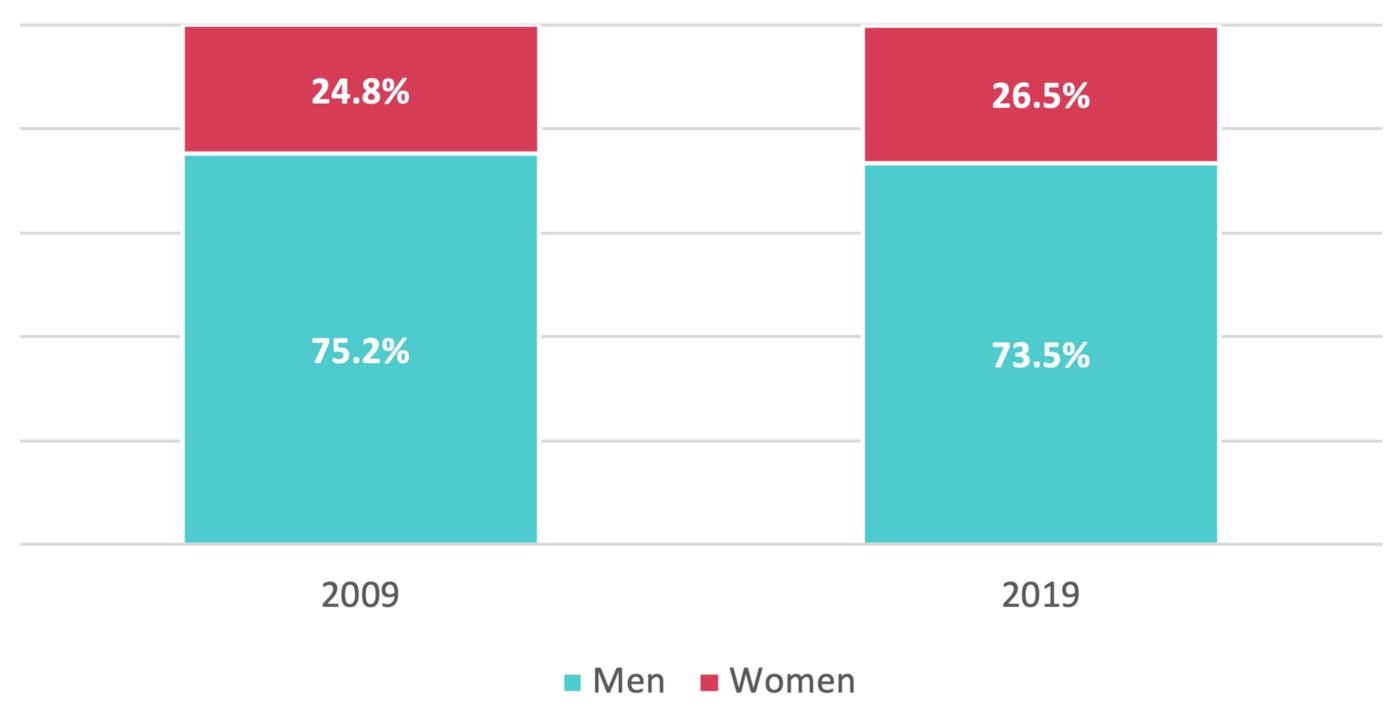
ICT employment by gender, 2009 and 2019 — Source: ICTC; Statistics Canada
Since 2009, the employment of women grew by 13% across all sectors of the economy, compared to a 15% growth in employment among men. Moreover, during that time, ICT employment for women increased by 52%, compared to 39% for men.

Employment growth by gender and type of job 2009 - 2019 — Source: ICTC; Statistics Canada
The unemployment rate for women in ICT professions was 2.5% in 2019, less than half of the unemployment rate for women throughout the entire Canadian economy (5.3%).
The representation of women in the ICT workforce also fluctuates across provinces. In 2019, women made up the largest share of ICT professionals in New Brunswick (28.4%), Alberta (27.9%), and Ontario (27.6%). The representation of women among ICT professionals was lowest in Newfoundland and Labrador (18.9%), Nova Scotia (23.7%), and Quebec (24.1%).
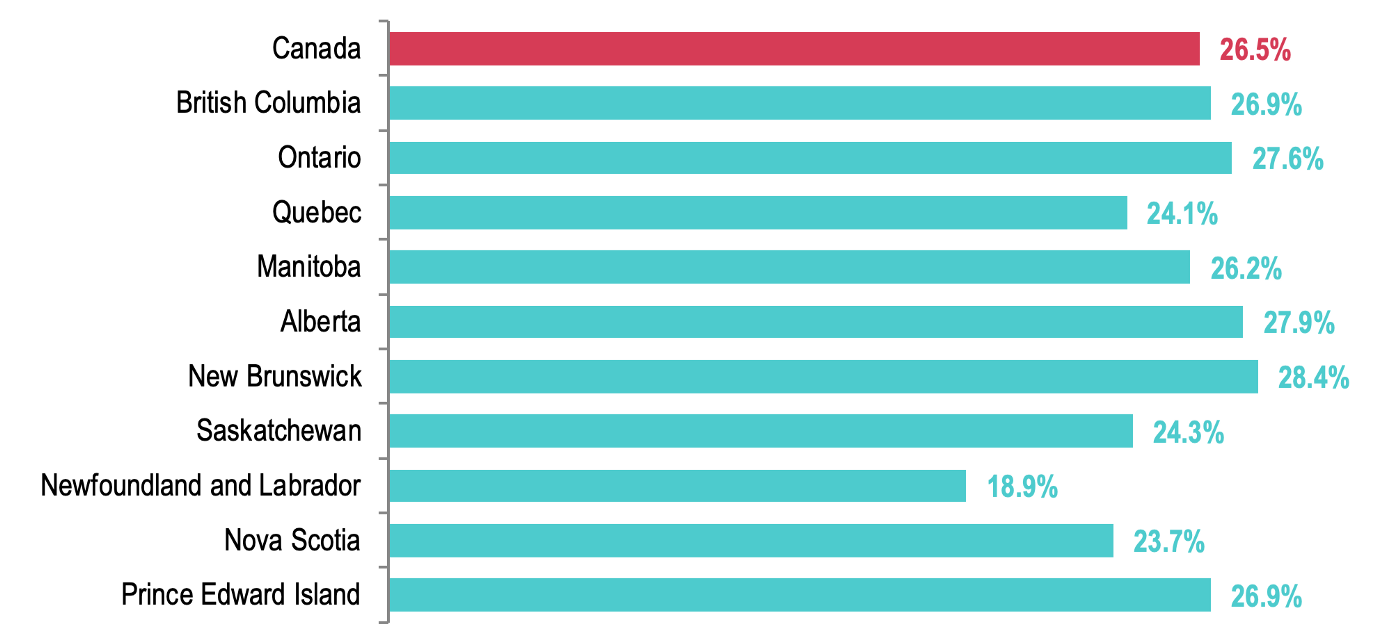
Proportion of women in ICT positions by province, 2019 — Source: ICTC; Statistics Canada
Youth in ICT
Youth (those aged 15 to 24 years old) represented 8.1% of all ICT workers in Canada in 2019. Between 2009 and 2019, the number of youth employed in ICT grew from 80,300 to 118,300 (47% growth). The share of youth working in the ICT sector is slightly higher than it was in 2009 — it was 7.8% then. Between 2009 and 2019, the share of older workers (aged 55 to 64) working in the ICT sector increased from 9% to 13%.
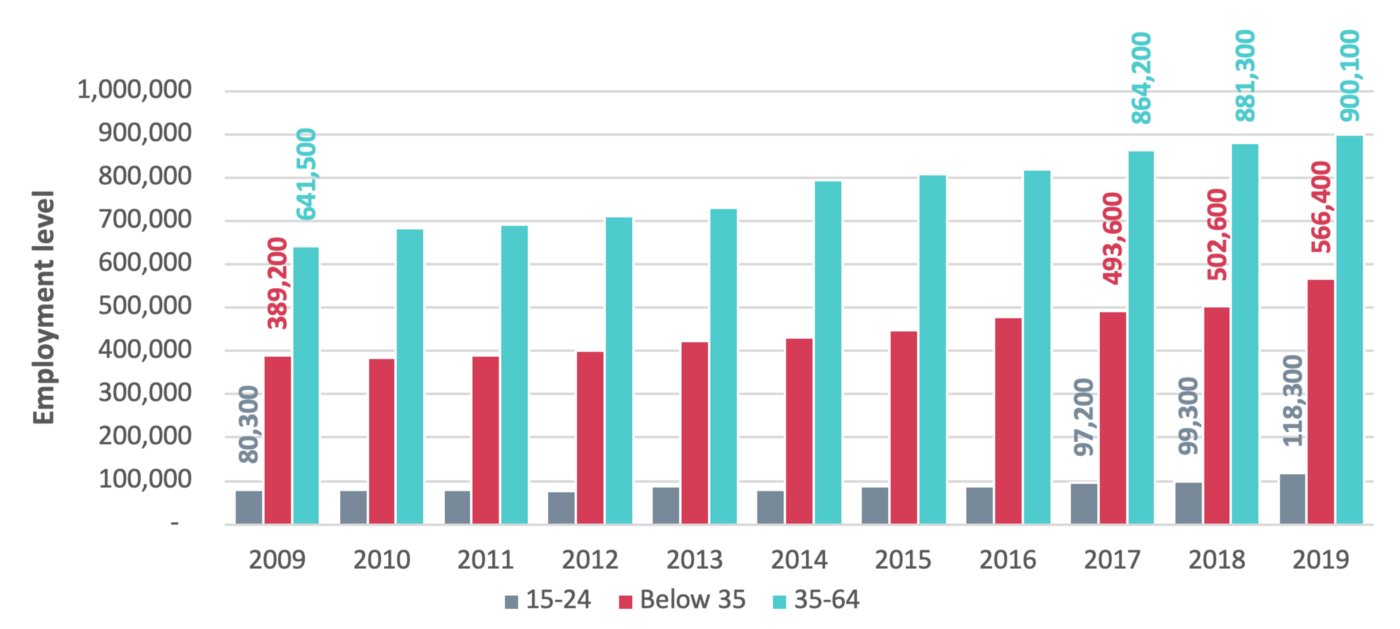
ICT employment by age groups 2009–2019 — Source: ICTC; Statistics Canada
Between 2009 and 2019, ICT employment among those aged 15 to 34 and under grew from 389,200 to 566,400 (46% growth). This corresponded to a small increase in the share of these workers among the ICT workforce, from 37.8% to 38.7%. Over the same time, the 35 to 54 age group saw a decline which was counterbalanced by a substantial rise in the 55 to 64 category, from 9% to 13% of total ICT industry. Compared to the wider Canadian economy, the ICT sector continues to overrepresent people in the 25 to34 and 35 to 54 age groups, while under representing youth and older workers.
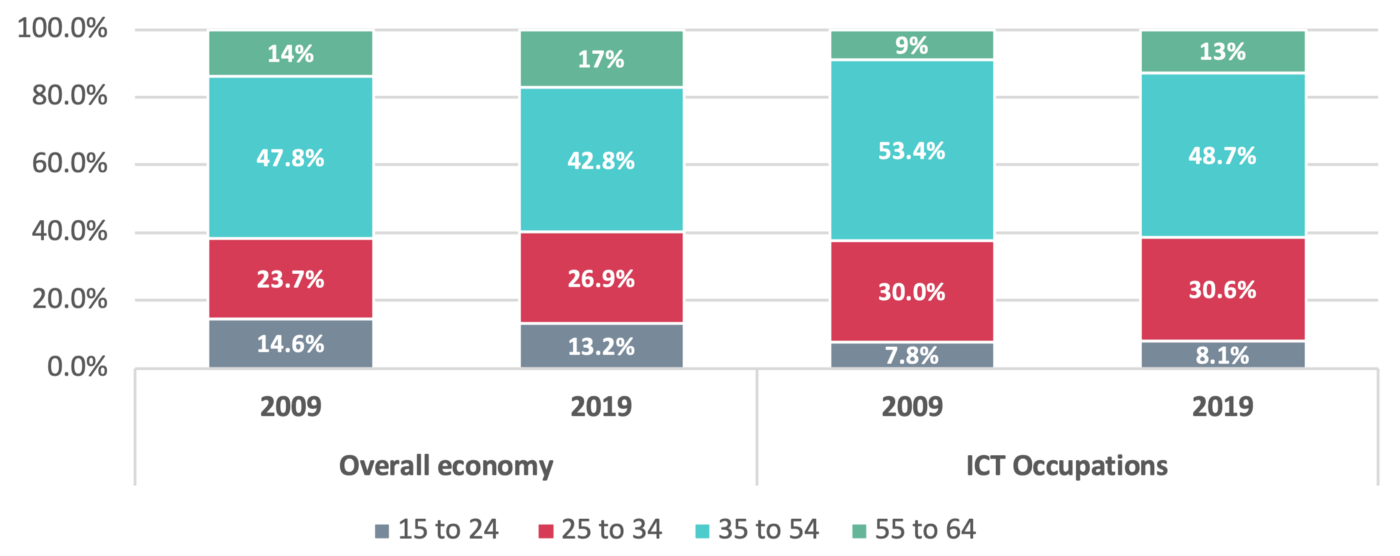
ICT employment breakdown by age 2008 vs 2018 — Source: ICTC; Statistics Canada
The unemployment rate for youth in ICT professions averaged 5.4% in 2019. By comparison, the unemployment rate for youth in the overall Canadian economy during 2018 was more than double that, averaging 11.0%.
Immigrants in ICT
546,300 of Canada’s ICT jobs were held by immigrants in 2019.[1] Overall, the share of Canada’s ICT positions occupied by immigrants has grown from 26% in 2009 to 37% in 2019. In the same period, the share jobs in the wider economy held by immigrants grew from 22% to 28%. The elevated share of immigrants in ICT professions is evidence of the strong demand for ICT talent throughout the Canadian economy.
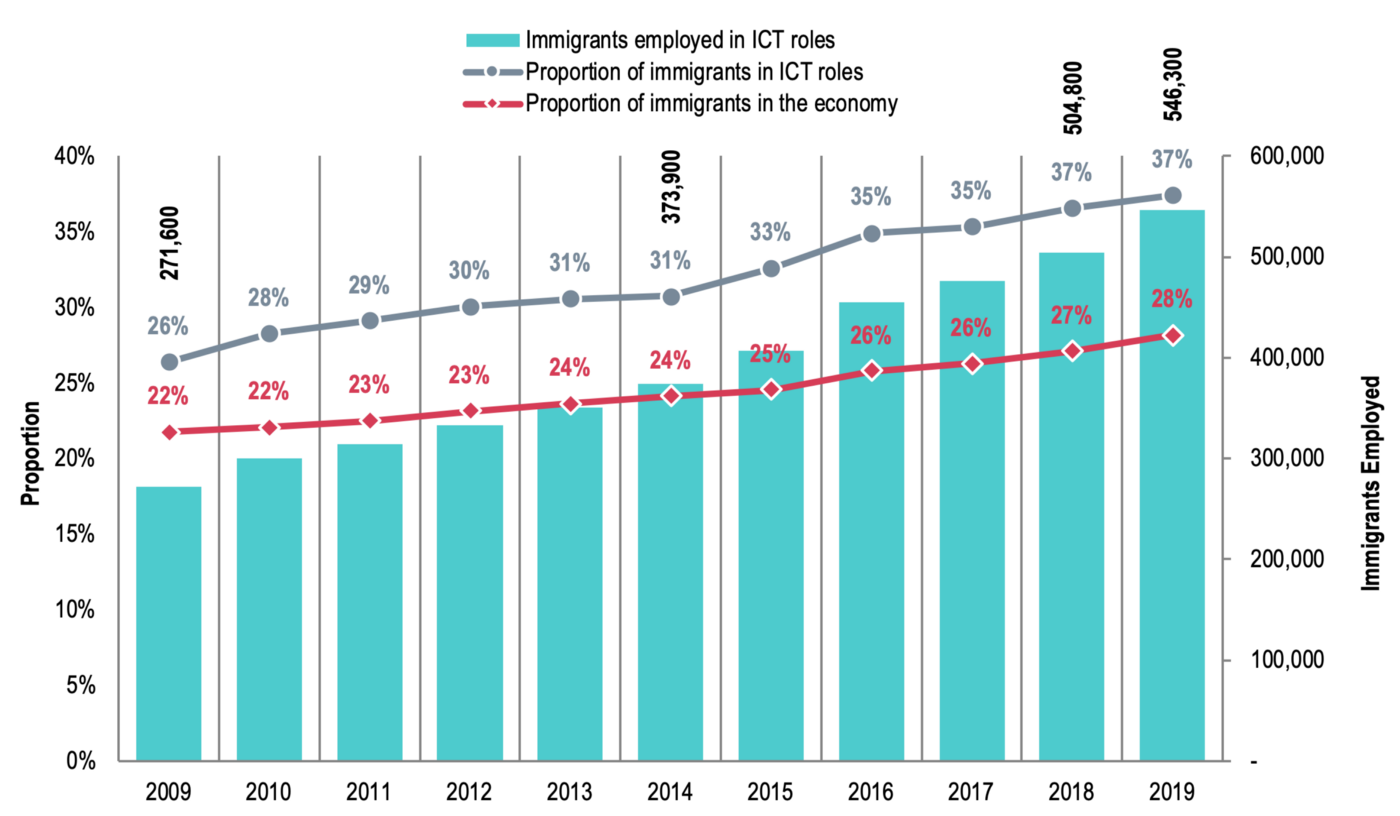
Employment for immigrants 2009–2019 — Source: ICTC; Statistics Canada
From 2009 to 2019 the number of immigrants employed in ICT roles more than doubled from 271,600 to 546,300. Between 2010 and 2019, ICT employment of immigrants grew at an average rate of 7% a year, compared to 4% for employment of immigrants in the wider economy.

Growth in employment among immigrants 2010–2019 — Source: ICTC; Statistics Canada
Unemployment amongst ICT immigrant professionals was consistently low at 2.7% in 2019 and has remained relatively steady over the past five years. By contrast, the unemployment rate among immigrants in the overall Canadian economy was 6.2%.
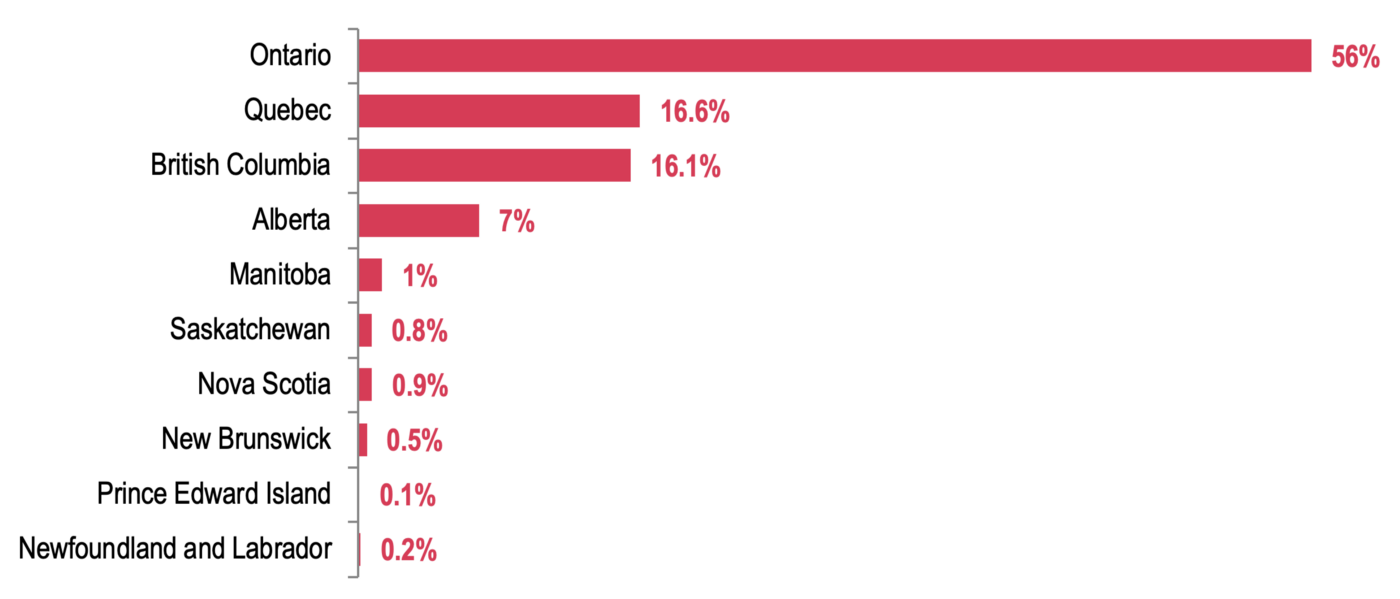
Proportion of immigrants in ICT positions by province, 2019 — Source: ICTC; Statistics Canada
In 2019, Ontario employed 307,100 immigrants in ICT and accounted for 56% of Canada’s immigrant ICT workforce. Quebec employed 90,900 immigrants in ICT roles; BC employed 87,900; and Alberta employed 39,100. In total, 95.7% of Canada’s immigrant ICT workforce worked in one of the four most populous provinces.
Canada’s digital economy has a lot to look forward to — in the long term
Greater technology adoption holds tremendous promise for the entire Canadian economy. While the ICT industry is a key pillar of Canada’s economy and has seen substantial growth, its growth is only a small part of the economic impact of technology in Canada; roughly two-thirds of Canada’s ICT employees work outside the ICT sector. Technologies such as AI are being rapidly adopted to deliver value in sectors as diverse as Agriculture, Manufacturing, Retail, Resource Extraction, and Health.
Whether Canada can continue exploiting its digital potential will depend on whether Canadians are equipped with the skills to innovate new technologies and adopt existing ones to create value. Ensuring Canadian workers have the talent to create and use technologies is more critical than ever before. Partnership and communication between industry, government, and the education sector can be leveraged to ensure a smooth pipeline of talent that creates start-ups and satisfied the needs of established employers.
Interested readers are encouraged to review ICTC’s recent research exploring the long-term labour market outlook, talent solutions, and the adoption of digital technology by Canadian enterprises of all sizes. These studies provide insight at the municipal, provincial and federal level. This insight is designed to assist employers, policymakers and educators to optimize their contributions to the digital economy through appropriate policies and training programs.
Recent ICTC insights, studies, and solutions addressing these issues include:
- On The Edge of Tomorrow: Canada’s AI-Augmented Workforce
- Building Canadian Consensus: Our Maturing Blockchain Ecosystem
- Canada’s Growth Currency: Digital Talent Outlook 2023
- Smart City Priority Areas and Labour Market Readiness for Canadians
- A Digital Future for Alberta
- Developing Cyber Talent for Canadian Critical Infrastructure — Road Transportation
- 5G Jumpstarting our Digital Future
- ICTC’s Perspectives on a Data Economy Strategy: Empowering Canada’s 4th Industrial Revolution
[1] Refers to people who were born outside of Canada
